Roman Sadovsky looking for results on the ISU Junior Grand Prix circuit
THORNHILL, ONT: The humidity rests heavily at 33 degrees Celsius on a bright August afternoon, but inside the Ed Sackfield Arena, it’s cool enough for down coats and mittens. And Roman Sadovsky.
He’s winding up for a triple Axel, again and again. And it’s coming. That’s what summers are about at the York Region Skating Academy.
Sadovsky is a 14-year-old dynamo who has just experienced his first day at a special sports high school in the area. And yes, they start in August. It’s all new, but then Sadovsky is proving that he’s quite capable of taking some very big strides. Two years ago, he was a novice skater. Last year he was a junior, finishing third in a Junior Grand Prix in Lake Placid, N.Y. This year, the son of Ukrainian immigrants is going for all the marbles. He’s moving into the senior ranks despite his youth, at least nationally.
He’s preparing for the Thornhill Summer Skate Aug. 15 to 18, not at all daunted by who he’s supposed to meet. Three-time world champion Patrick Chan – a skater he looks up to – was among the original entries. Sadovsky isn’t intimidated. He’s looking forward to it. “It just feels so good, when you’re the youngest in the group and you get to be with those guys,” he says. “I’m not afraid or anything.”
He also has a Junior Grand Prix in Latvia the following week. Internationally, he’s remaining a junior.
Last year, Sadovsky had won the junior men’s division at the Skate Canada Challenge event, qualifying him for the Canadian Tire National Figure Skating Championships in Mississauga, Ont. He didn’t make it to nationals because of a stress fracture in his right foot, but he defeated some competitors who did go. And his points were higher than those who won medals. Sadovsky won his Skate Canada Challenge division with 172.58 points, while training mate Anthony Kan won the junior title in his absence with 167.54.
Sadovsky could have stayed at the junior level this year, reasoned coach Tracy Wainman. But the only competition he missed all year was nationals, and he was the alternate to go to the junior world championships: a major goal. Somewhere down the road, he wants to rule the junior world, but to do that, he’ll have to match the lads at the top, who are currently doing triple Axels and even quads. He’s working diligently on what he needs: a triple Lutz – triple toe loop and a triple Axel.
Last year, at age 13, Sadovsky was the youngest on the junior circuit. ISU rules say a skater must have turned 13 by the previous July 1 to compete at the international junior level – and Sadovsky’s birthday is May 31. “We have a lot of years left on that circuit,” Wainman says. Still, they didn’t have to think very long about launching Sadovsky into the senior level nationally, to at least compete against skaters who are doing the tricks that the international juniors are doing.
As young as he is, Sadovksy skates much more like a mature skater. “You forget how old he is,” Wainman says. On the ice, he’s very serious and focused. Barely pushing five feet tall, Sadovsky gets it: he knows what to do. “He always has a plan,” says Gregorz Filipowski, his choreographer. He understands the nuances of the code-of-points system. He’s an entertainer, too. “I just like performing and trying to tell the story,” he says.
Sadovsky’s body movement is impressive and his spins are exquisite. “He has a wonderful body,” says Skate Canada consultant Louis Stong. “He can stretch and he can hold and the spins are fast. On a camel spin, he gets right in on the outside edge, that body just stretches for days, and he gets those six turns in, and then he reaches back and does a variation, then he reaches with the other arm and changes, and does another variation. And you’re going: ‘That’s level four, and on my god, it’s plus three. It’s fabulous.”
His jumping has also improved rapidly. As a novice, he did two triples (Salchow and toe loop), and learned both of them before he got his double Axel. Last season, he set to work diligently – his work ethic is legendary – and got all of the triples down pat, except for the triple Axel.
Sadovsky was primed for the Canadian championships last year, but just before the event, he felt a bit of pain in his right foot. He told Wainman that he couldn’t do the flip and the Lutz, because it hurt to tap in for take-off from the right foot. “He’s quite tough,” Wainman said. “He was still landing the jumps.”
Concerned about the pain, Wainman sent him for tests. On the day that the MRI test results came, Sadovsky had landed a triple-triple combo and a triple flip – even though he’d been suffering from a stress fracture on a growth plate near his toe. Still, Wainman could see that there was something wrong, and had put a rush on the tests. Wainman was the one who had to tell him that he could not compete at the Canadian championships. “It was a tough thing for me,” she says. “But he wasn’t surprised.”
Continued stress on the plate could have affected the growth of his foot – and the rest of his life. “He understood,” Wainman says. Still, Sadovsky would come to the rink – which at the time was just beside the public school he attended – and stretch, as if preparing for ice time. Then he’d walk away wistfully. He did watch the Canadian championships, but skipped the junior men’s event. Too tough. He focused on the senior men – his future.
Still, Sadovsky continued doing Pilates and swam (he was a competitive swimmer) to keep fit so that when he came back, it wasn’t so hard. He was off the ice for a month and slowly regained his jumps.
Sadovsky started skating when he was five years old, but just to learn to skate, he says. “I really wanted to play hockey. My coach said I had to give figure skating a try. I didn’t like the option that I had.”
He wanted to be a goalie, stopping shots, going for the save. His first pair of skates were hockey skates.
He came to Wainman when he was eight and very tiny, she recalls. He was always very disciplined, she found. She’d give him little projects to do and he’d return, showing improvement. “Obviously, he’s going to learn faster that way,” she says.
Grzegorz Filipowski, a 1980 world bronze medalist, admits that it is fun being Sadovsky’s choreographer. “He’s not shy at all,” Filipowski says. “He looks good in any kind of movement and he’s really willing to try things.” Wainman says he takes 30 minutes of ballet a day – and he wants to, something unusual for his age.
“You get a sense that he’s the kind of guy who knows what he wants,” Filipowski says. “He’s still a kid but whenever he’s on the ice, he’s definitely a guy with a plan. He’s a smart guy. He knows his math. He knows the system in and out.”
And his spins? Filipowski is his spin coach. He doesn’t get many lessons, Filipowski says. The secret to success in doing good spins? Practice. Practice.
It’s taken a lot of work,” Sadovsky says. “I learned to do the spins with lots of effort.”
Sadovsky has already started his season, with a fifth-place finish against seniors at Skate Detroit in late July. He finished behind Californian Grant Hochstein, who landed a quad-triple in his short program, and Canadian bronze (senior) medalist Andrei Rogozine. But with 190.54 points, he finished only three-hundredths of a point behind seasoned Canadian veteran Jeremy Ten, and well ahead of 15-year-old Nam Nguyen, who moved into senior competition two years ago. And now Sadovsky is on the scene. It all bodes well for the future of men’s skating in Canada.
Beverley Smith


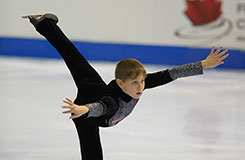
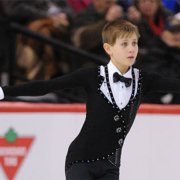
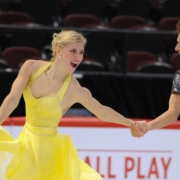
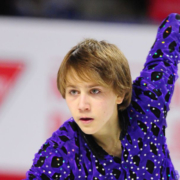
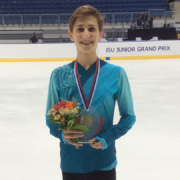
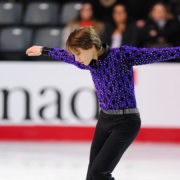
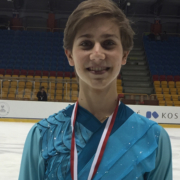
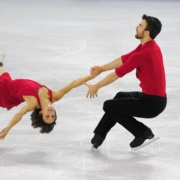



Leave a Reply
Want to join the discussion?Feel free to contribute!